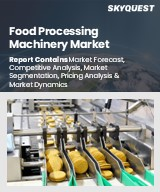
세계의 식품 가공 기계 시장 규모는 2023년 538억 달러로 평가되었고, 2024년 563억 8,000만 달러에서 2032년에는 820억 4,000만 달러로 성장하며 예측 기간(2025-2032년)의 CAGR은 4.8%를 나타낼 전망입니다.
세계의 식품 가공 기계 시장은 인구수 증가, 가공식품에 대한 소비자 수요 증가, 가처분소득 증가로 역동적인 성장을 이루고 있습니다. 이 급성장은 도시화의 동향과 현대적인 소매 채널의 보급에 의해 더욱 강화되고, 포장된 보존 가능한 식품에 대한 요구가 증가하고 있습니다. 라이프 스타일의 변화와 편의성에 대한 요구는 즉시 먹을 수 있는 식사에 대한 의존도를 높이고 효율적인 가공 기술에 대한 수요를 높입니다. 또한, 신흥 시장에서의 식품생산시설의 확대와 식품공급체인의 세계화가 시장의 기세에 크게 기여하고 있습니다. 기술 발전은 자동화, 에너지 효율, 정확성에 중점을 두고 있으며, 모듈 설계 혁신, 유지 보수 필요성 감소, 위생 기준 강화로 엄격한 식품 안전 규정 준수에 도움이 됩니다.
Global Food Processing Machinery Market size was valued at USD 53.8 billion in 2023 and is poised to grow from USD 56.38 billion in 2024 to USD 82.04 billion by 2032, growing at a CAGR of 4.8% during the forecast period (2025-2032).
The global food processing machinery market is witnessing robust growth, fueled by rising population numbers, heightened consumer demand for processed foods, and increasing disposable incomes. This surge is further supported by urbanization trends and the growing prevalence of modern retail channels, driving the need for packaged and shelf-stable food items. Changing lifestyles and the need for convenience are leading to greater reliance on ready-to-eat meals, escalating the demand for efficient processing technologies. Additionally, the expansion of food production facilities in emerging markets and the globalization of food supply chains are significantly contributing to market momentum. Technological advancements focus on automation, energy efficiency, and precision, with innovations in modular design, reduced maintenance needs, and enhanced hygiene standards helping to comply with rigorous food safety regulations.
Top-down and bottom-up approaches were used to estimate and validate the size of the Global Food Processing Machinery market and to estimate the size of various other dependent submarkets. The research methodology used to estimate the market size includes the following details: The key players in the market were identified through secondary research, and their market shares in the respective regions were determined through primary and secondary research. This entire procedure includes the study of the annual and financial reports of the top market players and extensive interviews for key insights from industry leaders such as CEOs, VPs, directors, and marketing executives. All percentage shares split, and breakdowns were determined using secondary sources and verified through Primary sources. All possible parameters that affect the markets covered in this research study have been accounted for, viewed in extensive detail, verified through primary research, and analyzed to get the final quantitative and qualitative data.
Global Food Processing Machinery Market Segments Analysis
Global Food Processing Machinery Market is segmented by Type, Operation, Application and region. Based on Type, the market is segmented into Depositor, Extruding Machines, Mixers, Refrigeration, Slicers & Dicers and Others. Based on Operation, the market is segmented into Semiautomatic and Fully Automatic. Based on Application, the market is segmented into Bakery & Confectionery, Meat, Poultry & Sea Foods, Dairy, Beverages and Others. Based on region, the market is segmented into North America, Europe, Asia Pacific, Latin America and Middle East & Africa.
Driver of the Global Food Processing Machinery Market
The rise in the urban population, coupled with changing lifestyles and busy work schedules, has led to a heightened demand for convenience and ready-to-eat foods globally. This increased consumer need is driving the requirement for efficient and scalable food processing equipment. As a result, companies are making significant investments in advanced machinery to adapt to evolving consumer preferences and enhance manufacturing efficiency. This shift not only addresses current market demands but also significantly propels the growth of the food processing machinery sector on a global scale, as businesses strive to keep pace with the dynamic food industry landscape.
Restraints in the Global Food Processing Machinery Market
The significant investment required for the installation of complex food processing machinery poses a considerable challenge for producers. The high costs associated with installation, employee training, and ongoing maintenance can be particularly burdensome for small and medium-sized enterprises (SMEs). As a result, smaller market participants may find these expenses prohibitive, limiting their access to the market and impeding their ability to adopt new technologies. This financial barrier can restrict growth in price-sensitive markets, hindering the overall expansion of the industry, even as the demand for enhanced automation and efficiency continues to rise consistently.
Market Trends of the Global Food Processing Machinery Market
The Global Food Processing Machinery market is experiencing a notable shift towards sustainable and energy-efficient solutions, driven by rising environmental consciousness and regulatory demands. Manufacturers are increasingly investing in machinery that minimizes energy consumption, conserves water, and reduces waste, aligning with the industry's commitment to sustainability. As operational costs escalate, companies are adopting green technologies not only to comply with stringent regulations but also as strategic moves to enhance their corporate image while lowering operational expenses. Consequently, environmentally friendly designs and innovations are becoming the norm in the development of new equipment, reflecting a broader trend towards sustainability in the food processing sector.